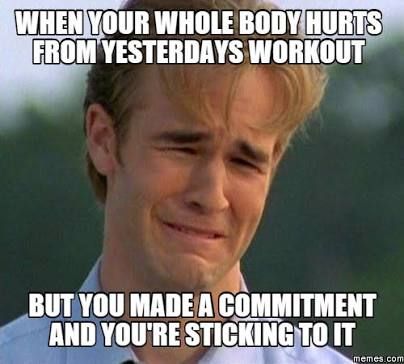Beginners guide to foam rolling
You know that 2 day post workout feeling? The one where you can’t lift your hands above your head? Or can’t bend your legs at the knees? This is all too common a reason why people quit working out. It’s too hard. It hurts. Is the pain worth it? Well I am here to tell you that there is a way to help you! Foam rolling. How do you even foam roll though? Well here is a beginners guide to foam rolling. This way you don’t have to long for an hour long massage every time you have a hard day in the gym.
Now foam rolling is not just for avid exercisers. Foam rolling is a type of self-massage that allows you to get rid of tightness or knots. It is also great for people who sit at a desk all day, have poor posture, joint issues or bad form while completing a task.

Benefits of Foam Rolling
It may seem like foam rolling is just an awful way to make your muscles hurt even more but there are TONS of benefits from foam rolling. Some of these include:
- alleviating soreness.
- reducing inflammation that occurs during the muscle repair process.
- aiding in muscle repair recovery.
- helps prevent injury by maintaining muscle length and remedying tension and tightness.
- increases blood flow and elasticity of muscle tissue, joints, and fascia. This helps with mobility, overall well-being, and a smoother appearance of fat underneath your skin.
- promotes relaxation. So roll away your worries!
So where do you start? How do you know what areas you should be foam rolling and how to do that?
Quads
One of the areas that is known to get the most sore is your legs! Even if you haven’t been doing a heavy squat routine, you still use them. Sitting at a desk all day can also cause the blood flow to be less to your legs so this one is for you too.
- Start in a forearm plank position with the roller under your quads.
- Bracing yourself with your upper body and core, begin to slowly roll down the roller until it reaches just above your knees. Then, roll in the opposite direction until you reach your hip flexors.
- Do this for 30 seconds.
- When you hit a tender spot, hold yourself there for a few breaths.
Hip flexors
Sitting for an extended period of time can really hurt your hip flexors. Stretching them may help but using a foam roller on them will help on loosening the muscle tissue plus the connective tissue (fascia) around it.
- Start by lying down, facing the floor on the foam roller, once again in a forearm plank position. Make sure the foam roller is underneath your left hip flexor and your right leg is bent comfortably to the side.
- Resting on your forearms, begin to roll slowly up and down and side to side on the foam roller to target the hip flexor, paying close attention to trigger points.
- Do this for 30 seconds.
- Switch and repeat on the right hip flexor.
Calves
Foam rolling your calves helps add just a little spring back to your step. This is also very helpful for those who run long distances and also jump a lot.
- Start by sitting on the floor with your legs extended, the foam roller positioned underneath your calves.
- Lift your body up so your weight is resting on the foam roller. Cross your left leg over your right for extra pressure.
- Begin to slowly roll your right calf back and forth on the foam roller, navigating your body forward and back with your arms.
- Complete for 30 seconds.
- Switch legs and focus on your left calf.
Hamstrings
Another leg muscle that can be affected from sitting a lot and also using them in a hard deadlift workout.
- Again, start by sitting on the floor with your legs extended. This time, position the foam roller underneath your hamstrings.
- Lift your body up so your weight is resting on the foam roller and begin to slowly roll up and down between the back of your knees and your glutes.
- Linger on tender spots, and roll for at least 30 seconds overall.
IT Band
So many people could benefit from foam rolling their IT Bands. The IT Band is the muscle on the outside of your thigh and is often confused with hip pain. It also is made of connective tissue that if foam rolled can help relieve other pain.
- Again, start by sitting on the floor with your legs extended. This time, position the foam roller underneath your hamstrings.
- Lift your body up so your weight is resting on the foam roller and begin to slowly roll up and down between the back of your knees and your glutes.
- Linger on tender spots, and roll for at least 30 seconds overall.
Upper back
Sitting with poor posture or feeling like your shoulder blades can never loosen up? Try foam rolling your upper back!
- Begin by lying on your back with the foam roller positioned underneath your upper back. Your knees should be bent with your feet flat on the floor and your arms can either be down by your sides or crossed in front of your chest.
- Brace your core and lift yourself up into a shallow bridge position.
- Slowly start to roll up and down between your lower neck and mid-back, stopping at tight areas along the way.
- Repeat for 30 seconds.
Lats
Also known sometimes as your “wings”, these muscles are often missed in the mobility aspect. Having tight lats can cause you to have poor posture and also lead to pain in other locations.
- Begin by lying on your back at a 45-degree angle with the foam roller positioned underneath your right lat. Keep your right leg straight and bend your left leg into a comfortable position.
- Slowly start to roll from your right armpit down to your mid-back area, focusing on tender areas.
- Repeat for 30 seconds.
- Switch to roll out your left lat.
Shoulders
So many of our patients come into our office with shoulder pain and foam rolling is one of the biggest things we talk to them about doing at home.
- Lie on your side with the foam roller underneath your right shoulder. Your lower body can be resting on the ground comfortably with your left arm out in front to guide movement.
- Roll slowly up and down over your deltoid muscle. Rotate your trunk slightly so you can hit part of your upper back as well if needed.
- Repeat for 30 seconds.
- Switch sides and repeat on your left shoulder.
Neck
When you deal with headaches, migraines and tension in your neck make sure you are foam rolling.
- Rest your neck on the foam roller, at the top where it connects to your head.
- Slowly turn your head to the right, holding where you feel a tightness.
- Exhale and turn your head to the left.
- Repeat for 30 seconds.

Tips and Tricks for Foam Rolling
Foam rolling can be painful, especially if you’re new to it. Pain in a specific area while foam rolling is typically a sign that your muscle or tissue is tight and needs some TLC. Don’t give up right when you start to feel a little uncomfortable.
We also have more options we can show you to help relieve tight muscles and pain in these areas at the clinic so make sure to ask us! For more tips and tricks follow us on social media. We have Facebook, Instagram, YouTube, and Tiktok.
You can also schedule your appointment HERE.
